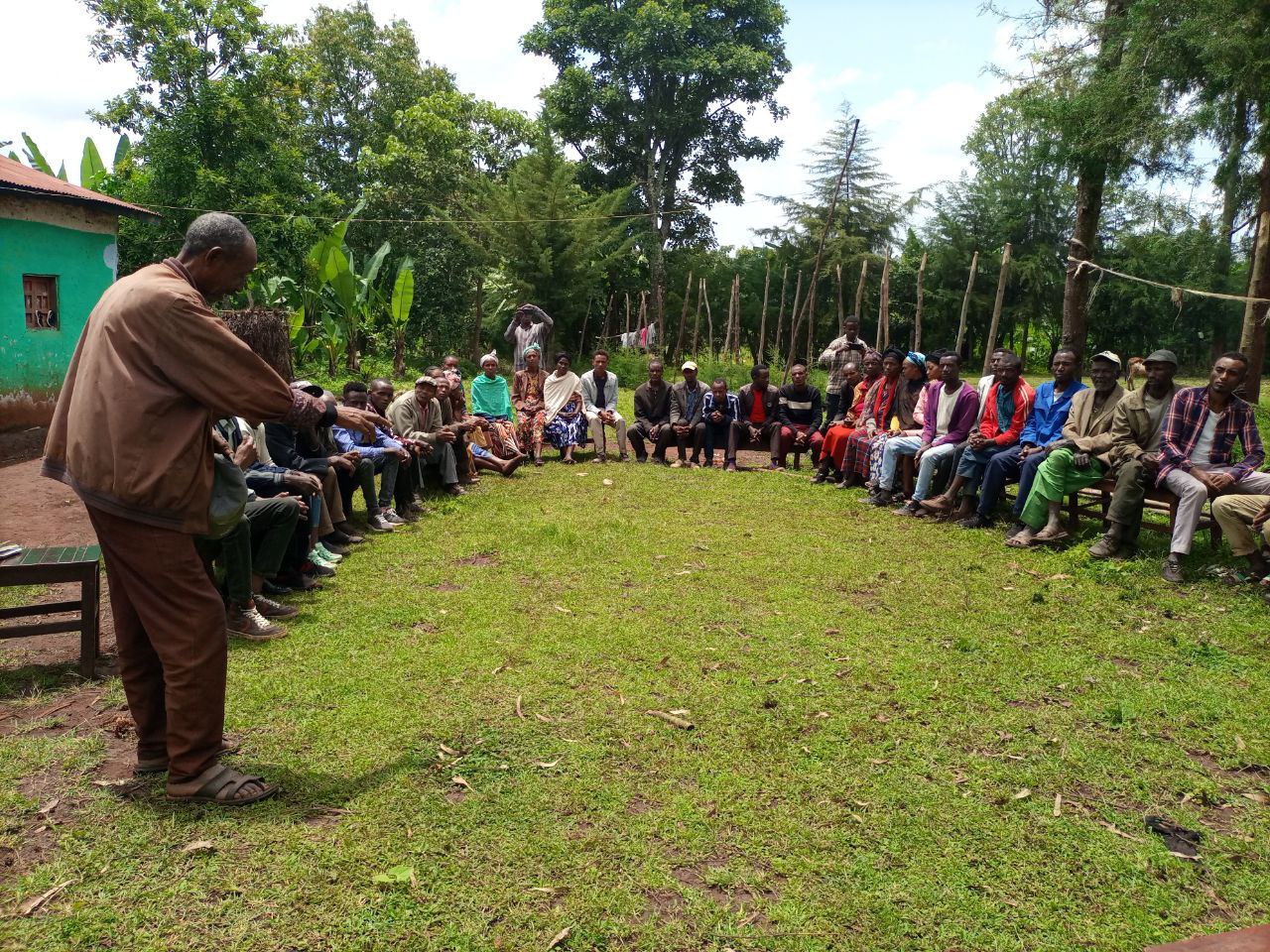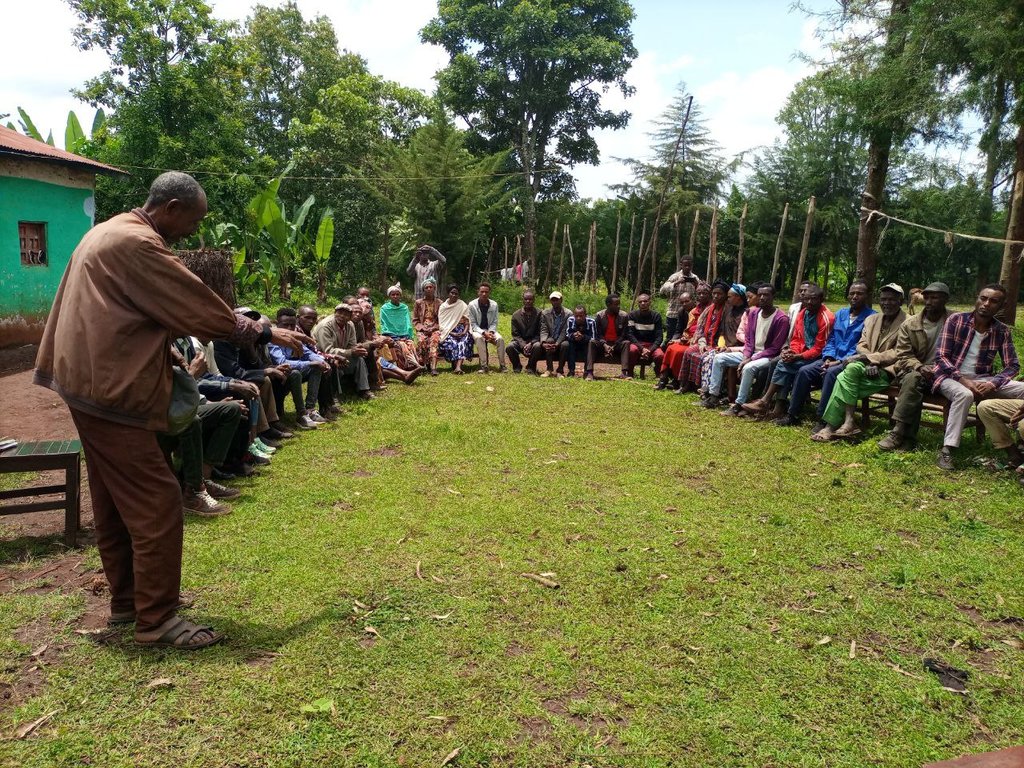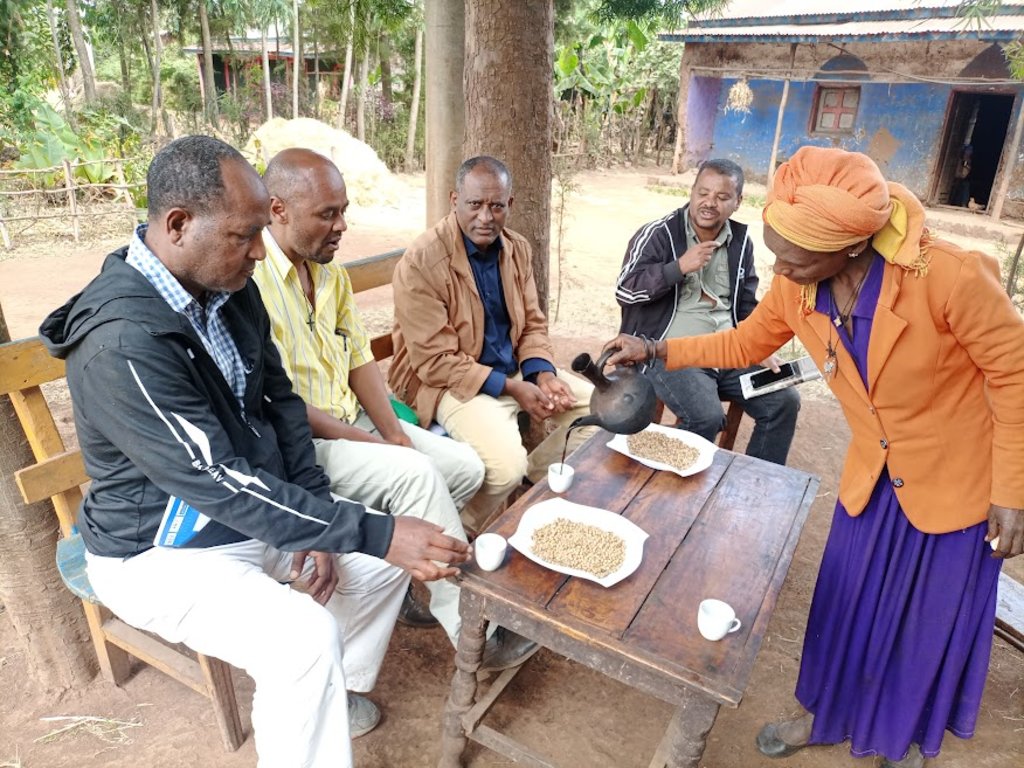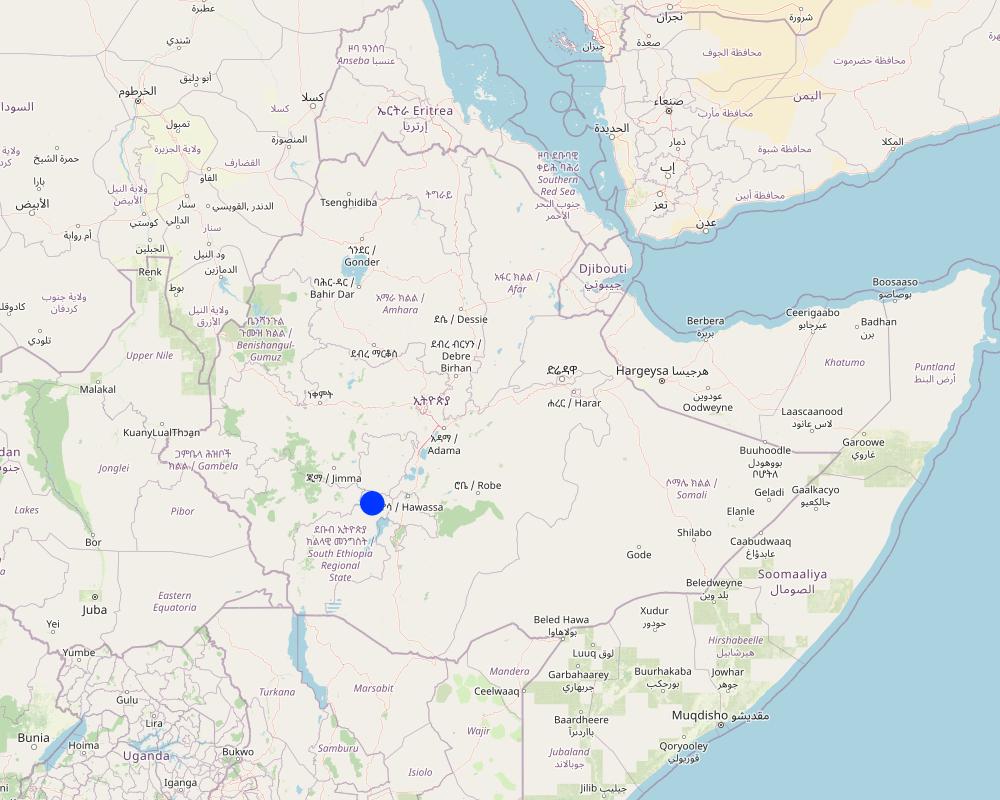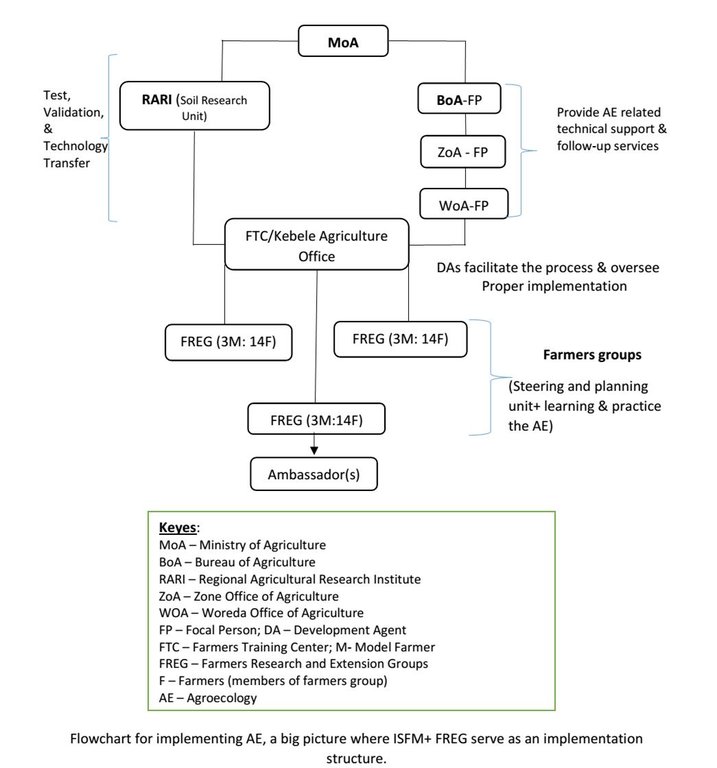Farmers Research and Extension Group (FREG) [ប្រទេសអេត្យូពី]
- ការបង្កើត៖
- បច្ចុប្បន្នភាព
- អ្នកចងក្រង៖ GERBA LETA
- អ្នកកែសម្រួល៖ Julia Doldt, Kidist Yilma, Noel Templer, Tabitha Nekesa, Ahmadou Gaye, Siagbé Golli
- អ្នកត្រួតពិនិត្យច្រើនទៀត៖ William Critchley, Rima Mekdaschi Studer, Sally Bunning
FREG
approaches_6629 - ប្រទេសអេត្យូពី
ពិនិត្យមើលគ្រប់ផ្នែក
ពង្រីកមើលទាំងអស់ បង្រួមទាំងអស់1. ព័ត៌មានទូទៅ
1.2 ព័ត៌មានលម្អិតពីបុគ្គលសំខាន់ៗ និងស្ថាប័នដែលចូលរួមក្នុងការវាយតម្លៃ និងចងក្រងឯកសារនៃវិធីសាស្ត្រផ្សព្វផ្សាយ
បុគ្គលសំខាន់ម្នាក់ (ច្រើននាក់)
អ្នកជំនាញឯកទេស SLM:
Feleke Temaledegn
+251967693410
temaledgn12@gmail.com
SNNPR Bureau of Agriculture
Hawassa
ប្រទេសអេត្យូពី
ឈ្មោះគម្រោងដែលបានចងក្រងឯកសារ/ វាយតម្លៃលើវិធីសាស្ត្រផ្សព្វផ្សាយ (បើទាក់ទង)
Soil protection and rehabilitation for food security (ProSo(i)l)ឈ្មោះអង្គភាពមួយ (ច្រើន) ដែលបានចងក្រងឯកសារ/ វាយតម្លៃលើវិធីសាស្ត្រផ្សព្វផ្សាយ (បើទាក់ទង)
CIAT International Center for Tropical Agriculture (CIAT International Center for Tropical Agriculture) - ប្រទេសកេនយ៉ា1.3 លក្ខខណ្ឌទាក់ទងទៅនឹងការប្រើប្រាស់ទិន្នន័យដែលបានចងក្រងតាមរយៈវ៉ូខេត
តើពេលណាដែលទិន្នន័យបានចងក្រង (នៅទីវាល)?
16/01/2023
អ្នកចងក្រង និង(បុគ្គលសំខាន់ៗ)យល់ព្រមទទួលយកនូវលក្ខខណ្ឌនានាទាក់ទងទៅនឹងការប្រើប្រាស់ទិន្នន័យដែលបានចងក្រងតាមរយៈ វ៉ូខេត:
បាទ/ចា៎
1.4 ការយោងមួយ (ច្រើន) ទៅលើ (កម្រង) បញ្ជីសំណួរនៃបច្ចេកទេស SLM
2. ការពណ៌នាអំពីវិធីសាស្ត្រផ្សព្វផ្សាយ SLM
2.1 ពណ៌នាសង្ខេបខ្លីពីវិធីសាស្ត្រផ្សព្វផ្សាយ
A Farmers Research and Extension Group (FREG) engages about 50 or more farmers in a kebele (lower administrative unit), with three sub groups of 17-20 each who live in a homogenous landscape. It is a local institution established for joint learning, piloting, and evaluating soil improvement technologies across the intervention regions.
2.2 ពណ៌នាលម្អិតពិវិធីសាស្ត្រផ្សព្វផ្សាយ
ពណ៌នាលម្អិតពិវិធីសាស្ត្រផ្សព្វផ្សាយ:
Farmers Research and Extension Groups (FREGs) are the approach used to test and spread Integrated Soil and Fertility Management (ISFM+)/Agroecology project best practices in Ethiopia. These technologies include livestock urine collection and use, cover crops, intercropping, vermicompost, acid soil treatment by liming, green manures, crop residue management, and bioslurry. A FREG employs a participatory approach, whereby joint investigation and learning is implemented. Farmers' group members use participatory planning and peer learning from one another. The approach is gender inclusive: one-third of the members in a FREG are women. There is also a mix of social categories. FREGs are populated by proactive model farmers who adopt and demonstrate technologies for scaling up. After the first year, the best-performing model farmer serves as an ambassador for knowledge and skills transfer to the indirect beneficiaries.
Collective investigation, learning, adoption, and then promotion of proven technologies are the key features of the approach. Member of the FREG jointly identify soil fertility/acidity-related issues, participate in training and demonstrate the technologies. The ISFM+/ Agroecology projects equip the target groups with implementation skills and knowledge. Site and participant selection are made with participation of woreda and kebele representative partners and the target farmers. Then soil-related issues are jointly identified with the support of laboratory analysis by the Regional Research Institute. This demonstrates that the intervention is implemented by the public research and development actors with technical, financial and/or inputs supply from the projects. The approach tends to mobilize the communities living in similar agroecology and farming systems who are subjected to the same SLM-related issues.
Identifying proactive model farmers and establishing demonstration plots for different technologies and crop types are the basis of collective learning. The demonstration is employed as an experimental and learning plot by showcasing and inspiring farmer groups and indirect beneficiaries in the area. Organizing field days and exchange visits further enables the demonstration of technologies for scaling out. Experience shows that where ISFM+ technologies have been piloted, farmers have built up new agroecology technologies such as cover cropping, intercropping and woodlots development over and above those previously adopted. Target farmers have piloted at least three or more technologies/practices on their plots. The woreda office of agriculture through the assigned project focal person gives closer follow-up for the proper implementation of the technologies. Provision of technical support and advisory service via the development agents (DAs) are among many other services.
2.3 រូបភាពនៃវិធីសាស្ត្រផ្សព្វផ្សាយ
2.5 ប្រទេស/តំបន់/ទីតាំងកន្លែង ដែលវិធីសាស្ត្រផ្សព្វផ្សាយត្រូវបានអនុវត្តន៍
ប្រទេស:
ប្រទេសអេត្យូពី
តំបន់/រដ្ឋ/ខេត្ត:
Southern Nations, Nationalities and People Region (SNNPR)
បញ្ជាក់បន្ថែមពីលក្ខណៈនៃទីតាំង:
Sodo Zuria district, Kuto-Sarfela kebele
Map
×2.6 កាលបរិច្ឆេទនៃការចាប់ផ្តើម និងបញ្ចប់នៃវិធីសាស្រ្តផ្សព្វផ្សាយនេះ
សូមបញ្ជាក់ឆ្នាំដែលបានបង្កើតឡើង:
2022
មតិយោបល់:
The project is expected to go up to the end of 2025.
2.7 ប្រភេទនៃវិធីសាស្ត្រផ្សព្វផ្សាយ
- ផ្អែកលើគម្រោង/កម្មវិធី
2.8 គោលបំណង/ទិសដៅសំខាន់នៃវិធីសាស្ត្រផ្សព្វផ្សាយ
To promote participatory implementation and peer-to-peer learning by increasing its scope from plot based to landscape scale. The approach capacitates the farmers' group and stimulates the scaling of the approach at a larger scale.
2.9 លក្ខខណ្ឌអនុញ្ញាត ឬរារាំងការអនុវត្តន៍បច្ចេកទេសដែលស្ថិតនៅក្រោមវិធីសាស្រ្តផ្សព្វផ្សាយ
សង្គម/វប្បធម៌/ និងតម្លៃនៃសាសនា
- អំណោយផល
Increasing soil degradation, growing infrequent moisture stress, and farmers' willingness to manage their land can be considered enabling factors.
- រារាំង
Giving priority to food crops due to shortage of farmland, climbing traits of the companion/cover crop that may cause harvesting inconvenience if not managed very well.
បរិបទនៃស្ថាប័ន
- អំណោយផល
The establishment of FREG at local level promotes the implementation of the technology. The involvement of public research and development actors support to implement evidence based and problem solving practices.
ការសហការ/ការសម្របសម្រួលតួអង្គពាក់ព័ន្ធ
- អំណោយផល
Woreda focal person, development agents, and farmers' group are supporting participatory planning, implementation, and evaluation. The involvement of different actors promotes collaboration and collective action.
ក្របខណ្ឌច្បាប់ (សិទ្ធិកាន់កាប់ដីធ្លី កម្មសិទ្ធីប្រើប្រាស់ដីនិងទឹក)
- អំណោយផល
The availability of a legal framework builds farmers' confidence to invest in their land.
គោលនយោបាយ
- អំណោយផល
Support the SLM initiative via the green legacy.
ចំណេះដឹងស្តីពី SLM និងការទទួលបានការគាំទ្រផ្នែកបច្ចេកទេស
- អំណោយផល
It facilitates effective implementation of technologies/approaches.
ទំហំការងារ ភាពអាចរកបាននៃកម្លាំងពលកម្ម
- រារាំង
Shortage of labor and costs are hindering appropriate implementation.
3. ការចូលរួម និងតួនាទីរបស់ភាគីពាក់ព័ន្ធ
3.1 អ្នកពាក់ព័ន្ធដែលបានចូលរួមក្នុងវិធីសាស្ត្រផ្សព្វផ្សាយ និងតួនាទីរបស់ពួកគេ
- អ្នកប្រើប្រាស់ដីក្នុងតំបន់/សហគមន៍
Members of farmers group
Participate in participatory planning, implementation, and evaluation of the intervention.
- អ្នកឯកទេសគ្រប់គ្រងដីប្រកបដោយចីរភាព/ទីប្រឹក្សាបច្ចេកទេសកសិកម្ម
Woreda Natural Resource Management experts or project focal person and development agents.
Facilitate farmers' group meetings during participatory planning, implementation, and participatory evaluation of the activities. Also, provide technical support to the implementers at the various stages of project implementation.
- រដ្ឋាភិបាលថ្នាក់មូលដ្ឋាន
Kebele administration
Assist in technology scaling up/out via mobilizing the community to learn and adopt from the pilot activities.
- រដ្ឋាភិបាលថ្នាក់ជាតិ (អ្នករៀបចំផែនការ អ្នកសម្រេចចិត្ត)
Ministry of Agriculture
Establish an agreement with the project and support it in steering the institutionalization of proven technologies for scaling out via policy support.
- អង្គការអន្តរជាតិ
GIZ
Provide financial, technical and material support to the partner organizations and the end users of the project intervention via the public line offices.
3.2 ការចូលរួមរបស់អ្នកប្រើប្រាស់ដីក្នុងតំបន់/ សហគមន៍ក្នុងតំបន់ក្នុងដំណាក់កាលផ្សេងគ្នានៃវិធីសាស្រ្តផ្សព្វផ្សាយ
| ការចូលរួមរបស់អ្នកប្រើប្រាស់ដីក្នុងតំបន់/សហគមន៍ក្នុងតំបន់ | សូមបញ្ជាក់នរណាត្រូវបានចូលរួម ព្រមទាំងពណ៌នាសកម្មភាពទាំងនោះ | |
|---|---|---|
| ការចាប់ផ្តើម/ការលើកទឹកចិត្ត | អន្តរកម្ម | Farmers' group involved in participatory planning, experience exchange visit, and evaluation of the activities. Agricultural experts, development agents, and project staff oversee the implementation of activities and provide technical support/advisory services. |
| ការរៀបចំផែនការ | អន្តរកម្ម | Target farmers and development agents involved in problem identification/assessment and planning. |
| ការអនុវត្តន៍ | អន្តរកម្ម | Farmers who are members of the FREG are involved in implementing the technology with technical support from the woreda focal person and the DAs. |
| ការត្រួតពិនិត្យ និងវាយតម្លៃ | អន្តរកម្ម |
3.3 គំនូសបំព្រួញ (ប្រសិនបើមាន)
ការពណ៌នា:
Agroecology/ISFM+ implementation flow chart that ran from the Ministry of Agriculture to the local level institution, the FREG. The role of stakeholders at different levels are briefly described in the flow chart.
អ្នកនិពន្ធ:
Gerba Leta
3.4 ការសម្រេចចិត្តលើការជ្រើសរើសបច្ចេកទេស SLM
សូមបញ្ជាក់តើអ្នកណាជាអ្នកបានសម្រេចចិត្តក្នុងការជ្រើសរើសបច្ចេកទេសដើម្បីយកមកអនុវត្តន៍:
- គ្រប់ភាគីពាក់ព័ន្ធទាំងអស់ដែលជាផ្នែកនៃវិធីសាស្រ្តផ្សព្វផ្សាយដោយមានការចូលរួម
ចូរពន្យល់:
Land users, SLM experts, Development Agents (DAs), and project advisors play a substantial role in participatory decision-making on the selection of SLM Technologies.
សូមបញ្ជាក់ តើការសម្រេចធ្វើឡើងដោយផ្អែកលើអ្វីជាមូលដ្ឋាន:
- វាយតម្លៃទៅលើចំណេះដឹងស្តីអំពី SLM ដែលបានចងក្រងជាឯកសារបានត្រឹមត្រូវ (ផ្អែកលើភស្តុតាងជាមូលដ្ឋានដើម្បីសម្រេចចិត្ត)
- លទ្ធផលបានពីការស្រាវជ្រាវ
4. ជំនួយបច្ចេកទេស ការកសាងសមត្ថភាព និងការគ្រប់គ្រងចំណេះដឹង
4.1 ការកសាងសមត្ថភាព/ បណ្តុះបណ្តាល
តើវគ្គបណ្តុះបណ្តាលបានផ្តល់ឱ្យអ្នកប្រើប្រាស់ដី/អ្នកពាក់ព័ន្ធផ្សេងៗទៀតដែរឬទេ?
បាទ/ចា៎
សូមបញ្ជាក់តើអ្នកណាត្រូវបានបណ្តុះបណ្តាល:
- អ្នកប្រើប្រាស់ដី
- បុគ្គលិកចុះទីវាល/អ្នកផ្តល់ប្រឹក្សាយោបល់
ប្រសិនទាក់ទង សូមបញ្ជាក់ ភេទ អាយុ ស្ថានភាពគ្រួសារ ជនជាតិដើមភាគតិច។ល។:
Women-headed households are a member of the three model farmers in the sub-group of FREG. In general, the approach involves women one-third of the group members.
ទម្រង់នៃការបណ្តុះបណ្តាល:
- អនុវត្តន៍ជាមួយការងារ
- ពីកសិករទីកសិករ
- ទីតាំងបង្ហាញ
- ការប្រជុំជាសាធារណៈ
ប្រធានបទបណ្តុះបណ្តាល:
The concepts of agroecology, integrated soil fertility management and overall benefits of cover cropping and related crops such as Desmodium.
មតិយោបល់:
The approach stimulates to conduct farmers group meeting at the beginning of the season as well as for end season evaluation of the pilot technologies.
4.2 សេវាផ្តល់ប្រឹក្សាយោបល់
តើអ្នកប្រើប្រាស់ដីបានទទួលនូវសេវាផ្តល់ប្រឹក្សាដែរ ឬទេ?
បាទ/ចា៎
សូមបញ្ជាក់ប្រសិនបើសេវាកម្មប្រឹក្សាយោបល់ត្រូវបានផ្តល់ឱ្យ:
- នៅលើដីរបស់អ្នកប្រើប្រាស់ដី
- នៅមជ្ឈមណ្ឌលជាអចិន្ត្រៃ
ពណ៌នា/ពន្យល់:
The advisory service is face-to-face on demonstration plots at various crop stages including for split application of Urea fertilizer, disease/pest management time, harvesting, and post-harvesting.
4.3 ការពង្រឹងសមត្ថភាពស្ថាប័ន (ការអភិរឌ្ឍន៍អង្គភាព)
តើស្ថាប័នទាំងអស់ត្រូវបានបង្កើតឡើង ឬពង្រឹងសមត្ថភាពតាមរយៈវិធីសាស្ត្រផ្សព្វផ្សាយដែរ ឬទេ?
- បាទ/ច៎ា ជាមធ្យម
សូមបញ្ជាក់ថាតើស្ថាប័នត្រូវបានពង្រឹង ឬបង្កើតឡើងនៅត្រឹមកម្រិតណា(ច្រើន)?
- ថ្នាក់មូលដ្ឋាន
ចូពណ៌នាពីស្ថាប័ន តួនាទី និងទំនួលខុសត្រូវ សមាជិក ។ល។:
FREG has three model farmers leading the group. They mobilize their followers, demonstrate technologies, and steer collective action. Farmers' groups along with agricultural experts and project staff support the selection of technologies and replacement of the existing ones if the need emerges.
- Facilitation/mobilization
4.4 ការត្រួតពិនិត្យ និងវាយតម្លៃ
តើការត្រួតពិនិត្យ និងវាយតម្លៃគឺជាផ្នែកមួយនៃវិធីសាស្ត្រដែរឬទេ?
បាទ/ចា៎
មតិយោបល់:
Participatory monitoring and evaluation are part of the FREG approach. Essentially, beginning and end-season evaluation is the approach employed in the implementation of new technologies.
ប្រសិន បាទ/ច៎ា តើឯកសារនេះបានបង្កើតឡើងក្នុងគោលបំណងប្រើប្រាស់សម្រាប់ការត្រួតពិនិត្យ និងវាយតម្លៃដែរឬទេ?
បាទ/ចា៎
4.5 ការស្រាវជ្រាវ
តើការស្រាវជ្រាវ គឺជាផ្នែកមួយនៃវិធីសាស្រ្តដែរឬទេ?
បាទ/ចា៎
បញ្ជាក់ប្រធានបទ:
- បច្ចេកវិទ្យា
សូមផ្តល់ព័ត៌មានបន្ថែមទៀតឱ្យបានលម្អិត និងចង្អុលបង្ហាញនរណាដែលបានធ្វើការស្រាវជ្រាវ:
Research is part of the introduced technologies. Problem identification is the entryway to introducing a new technology/practice. Regional Agricultural Research Institute involves in the assessment and identification of problems, evaluation, and issuance of appropriate recommendations that make the intervention evidence-based.
5. ថវិកា និងសម្ភារៈឧបត្ថម្ភពីខាងក្រៅ
5.1 ថវិកាប្រចាំឆ្នាំសម្រាប់ផ្សព្វផ្សាយ SLM
ប្រសិនបើចំនួនពិតប្រាកដនៃថវិកាប្រចាំឆ្នាំមិនត្រូវបានដឹងច្បាស់ សូមប្រាប់ពីចន្លោះនៃថវិកានោះ:
- 2,000-10,000
មតិយោបល់ (ឧ. ប្រភពសំខាន់នៃមូលនិធិ/ម្ចាស់ជំនួយចំបង):
The budget is generally allocated to support woreda's operational cost and to supply necessary inputs for the implementation of ISFM+ and the Agroecology projects.
5.2 ការគាំទ្រផ្នែកហិរញ្ញវត្ថុ / សម្ភារៈដែលបានផ្តល់ទៅឱ្យអ្នកប្រើប្រាស់ដី
តើអ្នកប្រើប្រាស់ដីបានទទួលការគាំទ្រផ្នែកហិរញ្ញវត្ថ/សម្ភារៈសម្រាប់ការអនុវត្តន៍បច្ចេកទេសដែរឬទេ:
ទេ
5.3 សូមបញ្ជាក់ពីធាតុចូលត្រូវបានផ្តល់បដិភាគ (រួមទាំងកម្លាំងពលកម្ម)
- គ្មាន
5.4 ឥណទាន
តើឥណទានដែលបានផ្តល់នៅក្រោមវិធីសាស្ត្រផ្សព្វផ្សាយសម្រាប់សកម្មភាព SLM នេះយ៉ាងដូចម្តេច?
ទេ
5.5 ការលើកទឹកចិត្ត ឬវិធីសាស្ត្រដ៏ទៃទៀត
តើមានការលើកទឹកចិត្តផ្សេងទៀត ឬឧបករណ៍ប្រើប្រាស់ដើម្បីលើកកម្ពស់ការអនុវត្តន៍បច្ចេកទេស SLM?
បាទ/ចា៎
បើបាទ/ចា៎ សូមបញ្ជាក់:
For best-performing farmers, incentives such as solar panels, energy-saving cooking stoves, wheelbarrows, etc., are offered to further motivate the farmers and enable them to properly implement the technology and become a very good advocator for scaling the beneficial practices.
6. ការវិភាគរកផលប៉ះពាល់ និងសេចក្តីសន្និដ្ឋាន
6.1 ផលប៉ះពាល់នៃវិធីសាស្ត្រផ្សព្វផ្សាយ
តើវិធីសាស្ត្រផ្សព្វផ្សាយបានផ្តល់សិទ្ធិអំណាចដល់អ្នកប្រើប្រាស់ដី ធ្វើឱ្យប្រសើរឡើងនូវការចួលរួមអ្នកពាក់ព័ន្ធ?
- ទេ
- បាទ/ច៎ា បន្តិចបន្តួច
- បាទ/ច៎ា ជាមធ្យម
- បាទ/ច៎ា បានខ្លាំង
Land users are decision makers on selection of technologies.
តើវិធីសាស្រ្តផ្សព្វផ្សាយនេះអនុញ្ញាតឱ្យធ្វើការសម្រេចចិត្ដដោយផ្អែកលើភស្តុតាងជាមូលដ្ឋានដែរ ឬទេ?
- ទេ
- បាទ/ច៎ា បន្តិចបន្តួច
- បាទ/ច៎ា ជាមធ្យម
- បាទ/ច៎ា បានខ្លាំង
Through piloting and learning from the technologies.
តើវិធីសាស្ត្រផ្សព្វផ្សាយជួយអ្នកប្រើប្រាស់ដីដើម្បីអនុវត្តន៍ និងថែទាំបច្ចេកទេស SLM?
- ទេ
- បាទ/ច៎ា បន្តិចបន្តួច
- បាទ/ច៎ា ជាមធ្យម
- បាទ/ច៎ា បានខ្លាំង
តើវិធីសាស្រ្តផ្សព្វផ្សាយនេះធ្វើឱ្យប្រសើរឡើងនូវការសម្របសម្រួលនិងការអនុវត្តចំណាយរបស់ SLMមានប្រសិទ្ធិភាពបែបណា? :
- ទេ
- បាទ/ច៎ា បន្តិចបន្តួច
- បាទ/ច៎ា ជាមធ្យម
- បាទ/ច៎ា បានខ្លាំង
តើវិធីសាស្រ្តផ្សព្វផ្សាយនេះប្រមូលផ្តុំ / ធ្វើឱ្យប្រសើរឡើងនូវការទទួលបានធនធានហិរញ្ញវត្ថុសម្រាប់ការអនុវត្ត SLM?
- ទេ
- បាទ/ច៎ា បន្តិចបន្តួច
- បាទ/ច៎ា ជាមធ្យម
- បាទ/ច៎ា បានខ្លាំង
តើវិធីសាស្ត្រផ្សព្វផ្សាយនេះធ្វើឱ្យចំណេះដឹងប្រសើឡើង និងសមត្ថភាពរបស់អ្នកប្រើប្រាស់ដីក្នុងការអនុវត្តន៏ SLM?
- ទេ
- បាទ/ច៎ា បន្តិចបន្តួច
- បាទ/ច៎ា ជាមធ្យម
- បាទ/ច៎ា បានខ្លាំង
តើវីធីសាស្ត្រផ្សព្វផ្សាយនេះពង្រឹងចំណេះដឹង និងកសាងសមត្ថភាពរបស់អ្នកពាក់ព័ន្ធឬទេ?
- ទេ
- បាទ/ច៎ា បន្តិចបន្តួច
- បាទ/ច៎ា ជាមធ្យម
- បាទ/ច៎ា បានខ្លាំង
តើវីធីសាស្ត្រនេះបានជួយកសាង/ពង្រឹងស្ថាប័ន កិច្ចសហប្រតិបត្តិការរវាងអ្នកពាក់ព័ន្ធដែរ ឬទេ?
- ទេ
- បាទ/ច៎ា បន្តិចបន្តួច
- បាទ/ច៎ា ជាមធ្យម
- បាទ/ច៎ា បានខ្លាំង
តើវីធីសាស្ត្រផ្សព្វផ្សាយនេះបានកាត់បន្ថយជំលោះឬទេ?
- ទេ
- បាទ/ច៎ា បន្តិចបន្តួច
- បាទ/ច៎ា ជាមធ្យម
- បាទ/ច៎ា បានខ្លាំង
តើវិធីសាស្ត្រផ្សព្វផ្សាយនេះផ្តល់សិទ្ធិអំណាចដល់សង្គមនិងសេដ្ឋកិច្ចដែលក្រុមមិនទទួលបានផលប្រយោជន៍?
- ទេ
- បាទ/ច៎ា បន្តិចបន្តួច
- បាទ/ច៎ា ជាមធ្យម
- បាទ/ច៎ា បានខ្លាំង
តើវិធីសាស្ត្រផ្សព្វផ្សាយ បានធ្វើឱ្យប្រសើរឡើងសមភាពយេនឌ័រ និងផ្តល់សិទិ្ធអំណាចដល់ស្ត្រី និងក្មេងស្រី?
- ទេ
- បាទ/ច៎ា បន្តិចបន្តួច
- បាទ/ច៎ា ជាមធ្យម
- បាទ/ច៎ា បានខ្លាំង
តើវិធីសាស្ត្រផ្សព្វផ្សាយបានលើកទឹកចិត្តដល់អ្នកប្រើប្រាស់ដីដែលជាយុវជន/ក្មេងជំនាន់ក្រោយឱ្យចូលរួមក្នុង SLM ?
- ទេ
- បាទ/ច៎ា បន្តិចបន្តួច
- បាទ/ច៎ា ជាមធ្យម
- បាទ/ច៎ា បានខ្លាំង
តើវិធីសាស្ត្រផ្សព្វផ្សាយបានឱ្យប្រសើរឡើងនូវបញ្ហាកាន់កាប់ដីធ្លី/សិទ្ធិអ្នកប្រើប្រាស់ដែលរារាំងដល់ការអនុវត្ត SLM?
- ទេ
- បាទ/ច៎ា បន្តិចបន្តួច
- បាទ/ច៎ា ជាមធ្យម
- បាទ/ច៎ា បានខ្លាំង
តើវិធីសាស្ត្រផ្សព្វផ្សាយនាំឱ្យប្រសើរឡើងនូវសន្តិសុខស្បៀង/ធ្វើឱ្យប្រសើរឡើងនូវអាហាររូបត្ថម្ភ?
- ទេ
- បាទ/ច៎ា បន្តិចបន្តួច
- បាទ/ច៎ា ជាមធ្យម
- បាទ/ច៎ា បានខ្លាំង
តើវិធីសាស្ត្រផ្សព្វផ្សាយធ្វើឱ្យប្រើសើរឡើងនូវការស្វែងរកទីផ្សារ?
- ទេ
- បាទ/ច៎ា បន្តិចបន្តួច
- បាទ/ច៎ា ជាមធ្យម
- បាទ/ច៎ា បានខ្លាំង
តើវិធីសាស្ត្រផ្សព្វផ្សាយនេះនាំឱ្យមានភាពប្រសើរឡើងក្នុងការទទួលបានទឹក និងអនាម័យ?
- ទេ
- បាទ/ច៎ា បន្តិចបន្តួច
- បាទ/ច៎ា ជាមធ្យម
- បាទ/ច៎ា បានខ្លាំង
តើវិធីសាស្ត្រផ្សព្វផ្សាយនេះនាំឱ្យមានកាប្រើប្រាស់ប្រកបដោយចីរភាព/ប្រភពនៃថាមពលកាន់តែប្រើសើរឡើង?
- ទេ
- បាទ/ច៎ា បន្តិចបន្តួច
- បាទ/ច៎ា ជាមធ្យម
- បាទ/ច៎ា បានខ្លាំង
តើវិធីសាស្ត្របានធ្វើឱ្យប្រសើរឡើងនូវការកសាងសមត្ថភាពរបស់អ្នកប្រើប្រាស់ដីដើម្បីបន្សុំាទៅនឹងការប្រែប្រួលអាកាសធាតុ/អាកាសធាតុក្តៅហែង និងកាត់បន្ថាយគ្រោះមហន្តរាយទាក់ទឹងនឹងអាកាសធាតុ?
- ទេ
- បាទ/ច៎ា បន្តិចបន្តួច
- បាទ/ច៎ា ជាមធ្យម
- បាទ/ច៎ា បានខ្លាំង
តើវិធីសាស្ត្រផ្សព្វផ្សាយនេះនាំឱ្យមានការងារ ឱកាសរកប្រាក់ចំណូល?
- ទេ
- បាទ/ច៎ា បន្តិចបន្តួច
- បាទ/ច៎ា ជាមធ្យម
- បាទ/ច៎ា បានខ្លាំង
6.2 ការលើកទឹកចិត្តចម្បងៗរបស់អ្នកប្រើប្រាស់ដីសម្រាប់ការអនុវត្តបច្ចេកទេស SLM
- បង្កើនផលិតកម្ម
The approach improves farmers' understanding of the benefits of improving soil fertility and soil health, and overall production, and productivity of the soil.
- បង្កើនប្រាក់ចំណេញ (សមត្ថភាព) បង្កើនអត្រាចំណេញ
- ការកាត់បន្ថយការធ្លាក់ចុះគុណភាពដី
- ពង្រឹងស្មារតីផ្នែកបរិស្ថាន
- លើកកម្ពស់ចំណេះដឹង និងជំនាញ SLM
6.3 សកម្មភាពផ្សព្វផ្សាយដែលប្រកបដោយចីរភាព
តើអ្នកប្រើប្រាស់ដីអាចធ្វើឱ្យមានចីរភាពនូវអ្វីដែលត្រូវបានអនុវត្តន៍តាមរយៈវិធីសាស្ត្រផ្សព្វផ្សាយដែរឬទេ(ដោយពុំមានការគាំទ្រពីអ្នកខាងក្រៅ)?
- បាទ/ចា៎
ប្រសិនបាទ/ច៎ា សូមរៀបរាប់ថាធ្វើយ៉ាងម៉េច:
The positive outcome of applying the FREG is considered as a payoff for participating farmers as it gave them the energy to sustain the adopted practices. The outputs of integrating technologies, collective learning, and action allow to see significant yield increment per unit of land, improved soil fertility and soil health, etc.
6.4 ភាពខ្លាំង/ គុណសម្បត្តិនៃវិធីសាស្ត្រផ្សព្វផ្សាយ
| ភាពខ្លាំង/ គុណសម្បត្តិ/ ឱកាស ទស្សនៈរបស់អ្នកប្រើប្រាស់ដី |
|---|
| Increases farmers understanding of SLM and enables to improve soil fertility and soil health. |
| Allows direct and indirect beneficiaries to adopt beneficial agricultural practices. |
| Promote peer learning to apply technologies that nurture soil fertility and increase crop production and productivity, supply feed to the livestock, manage pests... |
| ភាពខ្លាំង/ គុណសម្បត្តិ/ ឱកាស ទស្សនៈរបស់បុគ្គលសំខាន់ៗ |
|---|
| Ensure stakeholders' participation and allows the development of a sense of ownership of the technology. |
| Promote knowledge sharing for scaling out of the technologies. |
6.5 ភាពខ្សោយ/ គុណវិបត្តិនៃវិធីសាស្ត្រ និងរកដំណោះស្រាយ
| ភាពខ្សោយ/ គុណវិបត្តិ/ ហានិភ័យ ទស្សនៈរបស់អ្នកប្រើប្រាស់ដី | តើបច្ចេកទេសទាំងនោះបានដោះស្រាយបញ្ហាដូចម្តេច? |
|---|---|
| The farmers' group meeting is not so strong and there are absentees or dropouts because of the overlaps with other regular and casual meetings, and private chores. | Strengthening appropriate participation in planning, implementation, collective learning and action process. |
| ភាពខ្សោយ/ គុណវិបត្តិ/ ហានិភ័យក្នុងទស្សនៈរបស់បុគ្គលសំខាន់ៗ | តើបច្ចេកទេសទាំងនោះបានដោះស្រាយបញ្ហាដូចម្តេច? |
|---|---|
| Lower level of farmers' commitment and non-zealous to bring change with positive impacts. | Need regular follow-up and continuous awareness creation exercises. |
| Take the project intervention for granted | Mainstreaming further land-related issues and the necessity of adopting ISFM and agroecology practices to ensure the sustainability of the management intervention. |
7. ឯកសារយោង និងវេបសាយ
7.1 វិធីសាស្ត្រ/ ប្រភពនៃព័ត៌មាន
- តាមការចុះទីវាល ការស្រាវជ្រាវនៅទីវាល
Operational field visited.
- ការសម្ភាសន៍ជាមួយអ្នកប្រើប្រាស់ដី
Interview and discussion made with a land user.
- ការសម្ភាសន៍ជាមួយអ្នកជំនាញ/ ឯកទេស
A regional expert, project focal person, and regional advisor were consulted.
7.2 ឯកសារយោងដែលបានចេញផ្សាយ
ចំណងជើង អ្នកនិពន្ធ ឆ្នាំ ISBN:
Agricultural extension approach: evidence from an Integrated Soil Fertility Management project in Ethiopia. Leta, G., Schulz, S., Alemu, G. 2020. DOI: 10.15302/J-FASE-2020331
មានប្រភពមកពីណា? ថ្លៃដើមប៉ុន្មាន?
https://www.researchgate.net (Free online)
ចំណងជើង អ្នកនិពន្ធ ឆ្នាំ ISBN:
Evaluation of Farmer Research Extension Group as Extension Approach: The experience of Sida-Amhara Rural Development Program in Kalu District of Amhara Region, Ethiopia. Abebe, E. 2008.
មានប្រភពមកពីណា? ថ្លៃដើមប៉ុន្មាន?
https://depot.wur.nl/1129
7.3 ចូលទៅទាញយកឯកសារពាក់ព័ន្ធដែលមានលើបណ្តាញអ៊ិនធឺណែត
ចំណងជើង/ ពណ៌នា:
Farmer research and extension
វេបសាយ:
https://www.researchgate.net/publication/5055710_Farmer_research_and_extension
ចំណងជើង/ ពណ៌នា:
Basics of cover cropping
វេបសាយ:
https://organicgrowersschool.org/gardeners/library/basics-of-cover-cropping/
ការតភ្ជាប់ និងម៉ូឌុល
ពង្រីកមើលទាំងអស់ បង្រួមទាំងអស់ការតភ្ជាប់
គ្មានការតភ្ជាប់
ម៉ូឌុល
គ្មានម៉ូឌុល


